Algae come in many varieties and forms and more often than not, they are uninvited intruders rather than beautiful aquascape additions.

The good news is that there are also diverse types of aquarium algae eaters that you can employ to battle the nuisance.
These are not only fish but also shrimp and even snails.
Each of the 20 cleaners has developed an appetite towards different algal types, so you’d want a particular eater if you’re mainly dealing with, say, green or brown hair algae.
The cleaning algivorous crew is not strictly freshwater species.
Algal spores can also cause an outbreak in a saltwater environment, so nature has taken care of that, too.
No matter your fish tank setup of choice – freshwater planted, saltwater FOWLR, etc. – there’s probably an algae-eating critter that will work best for your problem.
Author’s note: Remember that your aquarium’s gallon capacity and size affect your choice. Some algae eaters will remain small, whereas others will grow quite large. I made sure to recommend both big and tiny species on this list.
Anyway, what fish or other aquatic inhabitants will eat algae in an aquarium?
Let Aquanswers show and help you pick the right one for your setup.

Before I move on to my top selections I need to make sure that you understand the nature of algae.
Oftentimes, when a nutrient imbalance occurs in new aquariums, algal spores explode and take over.
Research shows that in excessive amounts, it can be harmful to aquatic life.
It has also been documented that microalgal blooms are unsafe for your skin and us aquarists often put our hands in the aquarium water.
In some cases, you end up with hair algae or Black beard algae. These are the toughest to remove, whether with the aid of algae-eating fish or not.
There are plenty of factors you need to have control over and that you should get familiar with to make sure you’re on the right side of the battlefield.
I’ve described them all in a detailed guide concerning black beard algae removal, which is the most difficult one to eliminate (visit the link to learn more).
There, I go deep and share some unpopular gems that might be worth checking before proceeding to choose an algae-grazing species.
For example, if the pH levels in your planted tank have risen since the algae’s appearance, this is a sign that there’s a lack of CO2. This, in turn, will make the hair algae hard and unappetizing for fish.
Other food should be supplemented, such as algae wafers and vegetables, but we’ll get to that later.
Some of these species are classified as omnivores so the occasional frozen worm should be thrown in, as well. Research your choice before introducing an algae-focused eater to the aquarium.
Clean your aquarium for good with these TOP-performing hair algae eaters
The presence an algae eater is considered a fundamental building block of a healthy ecosystem, be it in an aquarium or an outdoors body of water.
Many categories of algae exist, which increases the chance of one of them adapting to your particular freshwater or saltwater fish tank and invading it. To achieve the best results it’s crucial to pick the right type of hair algae grazer.
Below, you’ll only find species that have been documented to consume this invader at very impressive rates.
Here are the best algae eaters for freshwater and saltwater aquariums:
1. True Siamese algae eater (Crossocheilus siamensis)

| Max. size: | 6 Inches (15 centimeters) |
| Suggested aquarium size: | 20 gallon long and above |
| Companion ideas: | tetras, danios, barbs (if in school of 4 or more), gouramis, angelfish, corydoras, guppies |
| Ph: | 6.5 to 8 |
| Fish tank type: | Freshwater |
True Siamese Algae Eaters native to south Asia, especially Thailand and Malaysia, is a well-known freshwater fish. It is highly credited for its efficiency in dealing with numerous types of algae in the aquarium. It is scientifically called Crossocheilus Siamesis.
The true Siamese algae eater has a slim, elongated body with horizontally run black stripes. It is silver or gold in color, and its streamlined body enables it to swim swiftly in water.
The true Siamese algae eater, which comes from the Crossocheilus genus, can reach a maximum size of about 6 inches or 15 cm.
This implies the need for a medium-sized freshwater tank.
This species is the epitome of the good guy in the aquarium. Not only will the Siamese algae eaters get rid of algae, but they also have a super peaceful and friendly temper. Anyway…
When I say “true” I mean an Actual Siamese Algae eater, not a Chinese one or a flying foxfish.
Fish stores may sometimes falsely advertise one as the other, so do your research on the appearance and care requirements of a true Siamese Algae Eater before purchasing one (hint: The black line on the side of a true SAE ends at the back of its tail fin, and not the beginning). Visit the link for more info on identification and care.
This algae-eating fish will relentlessly munch on even the most stubborn types of freshwater algae without wasting any time.
Many consider the Siamese Algae Eater the best fish for winning the battle with freshwater algae.
I agree with that statement.
Having a couple of these fish is a good reassurance against the emergence of uninvited vegetation, as you won’t have the opportunity to even witness it growing.
On that note, keep in mind that it may be better to get female Siamese algae eaters as the male ones may get extremely territorial among each other. Females are the ones that grow larger and do not appear as elongated as the males.
. The Siamese algae eater must be compatible with the community tank and other tank mates. It is a plus point that it has a wide range of compatibility with freshwater species owing to its inherent characteristics of behaving better with others. It can co-inhabit with other peaceful fish species like tetras, rasboras, and danios.
Anyhow, this species dislikes the company of red-tailed sharks, so keep that in mind if you’re planning to aim for the “freshwater shark tank look”. Visit the link for more shark-like fish ideas.
Community fish are always a better choice for an SAE’s tank mates, but avoid cichlids and other aggressive species.
Suggested aquarium equipment for a single True Siamese algae eater:
- ·Lights: BeamsWork DA FSPEC Pent. You will need aquarium grow lights suitable for heavily planted tanks, and the 30″ Beamswork fixture will do a fantastic job for a 20-gallon-long tank.
- ·Filter: if you choose to go with a 20-gallon aquarium for your Siamese Algae Eater,
Eheim 2215 Canister Filter will maintain an adequate water turnover for such a tank size. Compare offers for this aquarium filter at Amazon and Chewy. - ·Heater: Check out the 150-watt version of the Cobalt Aquatics Neo-Therm Heater at both Amazon and Chewy. The Cobalt heaters are shatterproof, have an adjustable temperature, and provide stable results.
Among its best-known features is the fact that this kind of Siamese Algae Eater can feed on different types of aquarium algae, leaving them none, just as the second name of this fish species, the Kissing Gourami, is called due to its manner of feeding. Most of these grazing fish favor algae all the time and will keep it well-cleaned. They also help maintain a healthy balance between the algae and other aquatic plants.
They not only consume green spot algae but also filamentous algae, which are also among the things they devour. Even cyanobacteria, which can invade the ecosystems, may be eliminated that way.
2. Rubber-lipped pleco (chaetostoma formosae)

| Max. size: | 4.2 at maximum (10.6 centimeters) |
| Suggested aquarium size: | 20 gallon long and above |
| Companion ideas: | tetras, danios, gouramis, mollies, Swordtails, platies, barbs, endlers, goldfish with caution |
| Ph: | 6.5 to 8 |
| Fish tank type: | Freshwater |
Lips of Plecos have a thicker structure, which has become a unique characteristic of the fish, explaining the title of the fish – rubber-lipped Plecos. They have a strong build, narrowing down to their tail. After careful analysis, these tail plates can be referred to as small, triangular armor plates, showing their avenue to self-preservation.
Lots of people ask about the species size. These fish measure around 4-6 inches (10-15 cm), which is perfect for medium-sized aquariums.
It is a small and peaceful fish that is not very popular in this hobby.
And I can’t help but wonder why.
Rubber-lipped Plecos have received the designation because of their rubbery, strong lips. Their bodies are shaped with an extended vessel covered with numerous tiny plates that function as protective cover-ups against other predators.
In terms of dimension, a Rubber-Lipped Pleco could reach around 4 to 6 inches (10 to 15 cm), which is just the right size to keep in a medium-sized aquarium.
It’s important to ensure that your Rubber-Lipped Plecos have peaceful, rivalry-free, and harmonious tank mates who will not prejudice them when competing for limited resources. They usually get on well with other slightly aggressive freshwater fish species, including tetras, rasboras, danios, and calm cichlids.
When it comes to demolishing unwanted algal growth, these guys are my go-to algae-eating fish recommendation.
Rubber lip Plecos also have another amazing skill: They consume every kind of freshwater algae. As a result, they are also excellent scavengers of the green layer creeping over tank surfaces, decorations, and even plant materials.
For the best results against the most stubborn algae, turn to a rubber-lipped pleco. This fish is one of the few small pleco species that will eat all kinds of freshwater algae, including the nasty black beard algae and even brown diatoms.
I’ve had my RL pleco for a while now. There are no traces of algae intruders, as I managed to “teach” my little friend to keep his appetite for them.
I wrote a complete guide on how to care for this fish, what to watch out for when getting one, and other peculiarities, including tank mates.
Visit the care guide on Rubber Lipped Plecos heret to learn more.
Anyway, A Rubber Lips pleco will clean a tank at spectacular rates. Here’s video proof of a single specimen cleaning a full-blown infestation in a 10-gallon tank in about a week.
This fish should be more popular.
First, you need to properly set up a buffer tank and avoid activities like cleaning the tank borders or rocks. The latter can be a place for fish to hide.
This means that the astronaut crew will relate the foods with astronauts eating the same food rations. This where they consume a much thinner layer of salty wafers, boxes of slowly sinking pellets, and vegetables like zucchini and cucumber from time to time is to avoid nutritional defects.
Don’t house Rubber Lipped plecos with other bottom-dwelling catfish, and keep in mind that, in general, these fish prefer subtropical water temperatures (71 to 78 °F) with a current.
Because of their preferred temperature range, rubber-lipped plecos can work as algae eaters in a goldfish tank. However, though small and peaceful, if not well-fed, hey may or may not try to eat the goldfish’s slime coat.
Suggested aquarium equipment for a Rubber-lipped pleco:
- Lights: As with the Siamese algae eater, I recommend getting the BeamsWork DA FSPEC Pent aquarium light for your Rubber-lipped pleco. This light is bright enough to maintain the live plant in your 20-gallon tank without causing extra algae issues.
- Heater: Considering the temperature ranges this fish can handle, you can keep them without a heater, just like a Goldfish. If you prefer to have a heater though, consider getting this 150-watt one at Amazon. This heater is great at keeping the set temperature in medium and bigger aquariums and is powerful enough to make up for any temperature swings during the cold months.
- Filter: Eheim 2215 Canister Filter. The Eheim 2215 is strong enough to maintain clean water even in an overstocked 20-gallon freshwater tank. You can get the Eheim at both Amazon and Chewy (and find the best offer). If you decide to keep just a couple of fish in there, you can go with Fluval 107.
3. Panda Garra (Garra flavatra)

| Max. size: | 4 inches but they usually remain around 3.2 (approximately 8 to 10 cm) |
| Suggested aquarium size: | 20 gallons and above |
| Companion ideas: | pretty much any peaceful community fish |
| Ph: | 6.5 to 7.5 |
| Fish tank type: | Freshwater |
Garra flavatra, more popularly known as Panda Garra, looks fascinating in the aquarium and greatly enjoys eating algae (one of the dream jobs many would like to occupy).
Known for its ability to efficiently eat up algae, offensively targeting the tough black beard algae, the Panda Garra fish is a sought-after aquarium fish for tanks struggling with algae over-expression.
The Panda Garra is a member of the Garra genus.
I’ve been meaning to include Panda Garra in this list since this post did not initially come with it.
However, with time and some observations, I am convinced that Panda Garra can be an excellent hair algae eater.
These fish grow to approximately 5 to 7.5 centimeters, making it perfect for medium to large tanks.
Panda Garra is gaining popularity for its unmatched ability to focus on and dispose of particularly tough-to-get-away algae types, like the black beard algae that commonly infest aquariums with their stubborn, fast growth.
Splendidly armed with algae-clearing mouthparts that enable them to cut into lightly embedded algae nuisances such as tank decorations, stones, and even leaves of plants, these tough creatures busily redo the aquatic environment with diligence by cleaning all the algae overgrowths.
These small creatures may appear insignificant, but they are recognized as highly effective tools against more troublesome types of algae, the most challenging of which is red tide algae.
Moreover, they also seem to demolish Black Beard Algae.
I would even argue that they are as effective in cleaning black hair algae as Rubber Lip Pleco fish.
Anyway, in terms of diet, the Panda Garra are classified as omnivores and will need some meat on their menu.
After they’re done with the hair algae in your tank, you should supply their diet with algae wafers and frozen or live foods.
The Panda Garra’s dietary needs primarily revolve around algae, with a specific preference for filamentous algae types like black beard algae.
Their constant grazing helps to keep aquarium surfaces clean and free from unsightly algae overgrowths, promoting a healthier aquatic environment.
While algae serve as their primary source of sustenance, Panda Garra fish may also accept supplemental feedings of algae wafers, sinking pellets, and occasionally blanched vegetables to ensure a well-rounded diet.
These fish are not picky and will accept almost any food you offer them.

Image by Ssmith989
Author’s note: While cleaning hair algae, you should feed your Panda Garras sparingly. Only supply them with meaty foods during this period. I recommend throwing something meaty in their tanks every second day. This way, you’ll stimulate their appetite for algae.
Anyway, the Panda Garra are not aggressive and are a preferred choice in community tanks.
Consider whether Panda Garra is compatible with other tank mates. Compatibility is required for peaceful coexistence. Panda Garra is able to coexist friendly and harmoniously with other species if they share temperament and water parameter preferences.
Ideal tank mates for Panda Garra include peaceful community fish such as tetras, rasboras, danios, and peaceful cichlids. These species typically inhabit different areas of the aquarium, minimizing competition for space and resources. Their non-aggressive nature also ensures a serene aquarium environment conducive to the well-being of all inhabitants.
It’s critical to avoid pairing Panda Garra with aggressive or territorial fish species that may outcompete or harass them. Aggressive cichlids, large barbs, and predatory species should be kept away to prevent stress and potential harm to the Panda Garra and other tank inhabitants.
I find their peaceful nature and attractive looks desirable and try to sneak them into my tanks at any opportunity.
4. Juvenile Chinese algae eater (Gyrinocheilus aymonieri)
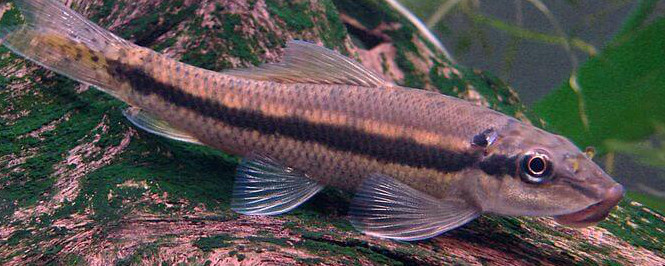
| Max. size: | 12 inches (30.5 centimeters) |
| Suggested aquarium size: | 55 gallons for juveniles and 100+ gallons for adults |
| Companion ideas: | zebra danios, tiger barbs, crayfish |
| Ph: | 6 to 8 |
| Fish tank type: | Freshwater |
The Juvenile Algae Eater scientific name Gyrinocheilus aymonieri is a precious asset for freshwater aquariums due to its outstanding capability to eat algae in the aquarium, it is also called Golden Chinese Algae Eater. The Chinese algae eater comes from the Gyrinocheilus genus.
If you’ve ever owned a Chinese Algae Eater, then you’d know why I put “juvenile” in the title.
As juveniles, these guys will restlessly clean your tank. They often shy away when you approach the aquarium, but as soon as you turn your back, they’ll get back to work.
Cute right?
Enjoy it while it lasts.
. Juvenile Algae Eaters have a special predilection for various types of algae, like green algae, diatoms, and filamentous algae, making them scavengers of aquarium tanks.
First of all, the CAEs grow fast and get just under a foot in max size.
A 10-gallon tank may seem appropriate for a juvenile, but you’ll quickly find yourself wondering where to house the evergrowing beast.
At a young age, they prevent algae growth in aquariums by regularly cleaning the tank if any algae growth occurs.
The downside is that mature juvenile Chinese Algae Eaters can reach up to 10 inches (25 centimeters) in length. Keep this in mind while considering these for aquariums.
Due to its huge size, it is a challenge for hobbyists with smaller setups.
As Juvenile Algae Eaters mature, their dietary predilection switches from algae to other food sources. They can consume and utilize algae to some extent by eating other foods such as flakes, live foods, etc.
A regular supply of such food is necessary for the well-being of juvenile Chinese Algae eaters otherwise their health deteriorates.
Secondly, upon maturity, they will lose their appetite for plants (algae) and start looking for protein.
Where they get that protein from will very often be their tank mates.
It is also reported by aquarists that fully mature Chinese Algae Eaters show a preference for coats or scale of tank mates which poses a serious threat to the survival of other inhabitants of the aquarium, which is of no value for aquarists.
Apart from that, Chinese Algae Eaters have been known to display territorial behavior as they mature, especially towards other bottom-dwelling fish species. Chinese Algae Eaters will also get super territorial as they age, so that’s another thing to consider.
This behavior can lead to violence among tank mates, requiring careful monitoring when choosing mates for Chinese Algae Eater.
The whole process is really creepy in nature.
You can avoid that by constantly keeping the adult CAEs fed with good, protein-rich food.
Unfortunately, not many people can be as diligent, and one day they will forget to dose the so-desired meal.
Coming home to your beautiful angelfish being eaten alive is not a pleasant experience.
If you have a large tank that needs cleaning, employing a juvenile algae eater may be appropriate, but be prepared for what’s coming after that.
5. American flagfish (Jordanella floridae)

| Max. size: | 2.2 inches (5.5 centimeters) |
| Suggested aquarium size: | 10 gallons and above |
| Companion ideas: | guppies, danios, platies, corydoras, otocinclus, school of tetras or barbs |
| Ph: | 6.8 to 8.1 |
| Fish tank type: | Freshwater |
They are indigenous to the southeastern United States, especially Florida; they are well known for their colorful pattern matching the American flag and their algae-consuming properties.
The American flagfish is one of the species within the Jordanella genus.
I am baffled that whenever algae eaters are discussed, these freshwater fish are never suggested.
The American Flagfish is a Killifish that’s so good at consuming freshwater algae that encouraging algal growth is recommended for these guys.
They don’t grow large (around 2 inches maximum) and have a great personality if you know what you’re doing.
The males are very beautiful, showing off nice colors, but may get a little territorial.
The females, however, are not as aggressive but are great centerpiece fish in smaller aquarium setups.
I would encourage anyone with a 10 to 20-gallon tank to get at least 3 female flagfish to keep freshwater algae at bay.
This fish prefers colder water but can gradually acclimate to warmer water temperatures.
American Flagfish are relatively hardy and adaptable, making them suitable for beginner aquarists. They thrive in well-maintained aquariums with stable water parameters, including a pH range of 6.8 to 8.1 and temperatures between 72 to 78°F (22 to 26°C).
The American Flagfish are well-reputed for their prompt hunger induction and utilize algae like green algae, filamentous algae, and black beard algae. They control algal overgrowth in aquariums by constantly eating them and cleaning the tank surfaces.
The American Flagfish demand a plant-based menu. Algae wafers and the occasional cucumber or spinach piece are a good choice.
Keep in mind that these algae-eating fish feel best in heavily planted tanks with plenty of hiding spaces, such as caves and driftwood.
American Flagfish showcases moderate interaction with other mates, constituting a peaceful environment. They are sociable and pleasant, coexisting with other serene fish species.
However, it is recommended to monitor their tendencies, especially during breeding season. Plenty of hiding and moving space and visual barriers can reduce conflicts among mates.
The flagfish may or may not munch on the freshwater plants in your aquarium.
The American Flagfish (Jordanella floridae) is one of the best choices for freshwater community tanks thanks to its adaptability and tranquility. They are appealing and charming, thus adding to the aquarium’s aesthetics.
The most common factor favoring the stability of American Flagfish for the community tank is their tranquil demeanor. They typically show non-aggressive tendencies towards other tank inhabitants.
Under normal circumstances, they are sociable and pleasant and can coexist harmoniously with other serene fish, such as tetras, rasboras, danios, and livebearers.
In addition to that, American Flagfish are relatively sturdy
and adaptable, making them the favorite of beginner aquarists and experienced hobbyists alike.
6. Bristlenose pleco (Ancistrus cirrhosus)
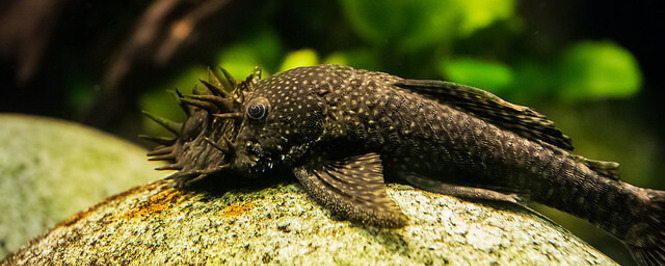
| Max. size: | 6 inches (15.2 centimeters) |
| Suggested aquarium size: | 30 gallons and above |
| Companion ideas: | danios, platies, school of tetras or barbs, mollies, guppies, swordtails, goldfish |
| Ph: | 6.5 to 7.8 |
| Fish tank type: | Freshwater |
The Bristlenose Pleco, scientifically called Ancistrus cirrhosus, native to South America, the Amazon Basin, is a renowned freshwater fish species held in high regard for its algae-controlling properties. They are also known as Bishynose pleco.
The Bristlenose plecos, or bristlenose catfish, are part of the Ancistrus genus.
A Bristlenose plecostomus will spend its time like every other plecostomus: they will glue themselves on the glass, scavenge the aquarium for algae, and happily hang out on driftwood.
Except Bristlenose Plecos will remain smallish when adult and won’t outgrow 6 inches.
This fish is super popular in the hobby because of its size, care level, and ability to clean a tank.
The whole family from which the Bristlenose Pleco comes is so effective at consuming huge amounts of algae that releasing them in the wild is known to wreak havoc on local ecosystems.
So don’t ever do that.
Anyway, the Bristlenose pleco has a rather stunning appearance – with age, they will develop mustache-like tentacles, which gives them a unique look. These tentacles are more pronounced in males and are believed to play a role in mating displays and territorial behavior.
The distinctive appearance is what sets Bathynus Bristelnose Pleco apart from the rest. While the more common Pleco (Hypostomus plecostomus) could eventually grow up to 12 inches, Bristlenose Pleco will forever remain relatively small, typically reaching up to 4 to 6 inches.
They can be either bumpy or smooth, with small plates and brown and black coloring so that they perfectly match their surroundings by blending into them.
Another of their most remarkable aspects is the firm, bristle-like appendages that sprout out of their snout and head, which is where these animals get their name.
There are also different varieties, such as long-finned Bristlenose or albino.
It’s an aesthetically pleasing fish species that will keep a clean look in your aquarium.
Don’t house your Bristlenose pleco with similar-looking fish that dwell at the bottom of the tank, as there may be territory disputes.
One of the most important roles played by Bristlenose Pleco in the aquarium is controlling algae. They eat algae voraciously. They have specialized mouthparts designed to scrape algae off surfaces. They can control algae growth, thus keeping the aquarium surroundings clean and tidy.
Bristlenose plecos are known to collaborate well with goldfish in an algae-infested aquarium. Along with the rubber-lipped pleco and the rosy barb, these are the only 3 species of fish that make sense as algae-eating tank mates for goldfish aquariums.
Bristlenose catfish are usually quiet, which makes them suitable for community aquariums because they live peacefully with many other fish species. Community fish such as tetras, guppies, and mollies love them.
Besides, angelfish and discus cichlids, one of the most peaceful species, are also good tank mates for them. Nevertheless, only the selection of calm and peaceable fish as tankmates will give them much-needed protection since they are easy prey for more aggressive or territorial species.
Tank Setup and Maintenance:
To provide an optimal environment for Bristlenose Plecos, it is essential to set up the aquarium appropriately and maintain it regularly:
Tank Size:
We recommend a 20-gallon minimum tank capacity for a Bristlenose Pleco alone. Bigger holding tanks should be obligatory, especially if multiple species or other fish species must be separated.
Water Parameters:
Bristlenose Plecos tend to be very adaptable to water pH and temperature if they are slightly acidic (6.5-7.5) and slightly neutral (72-80°F), respectively. Be sure of the quality of the water by conducting regular water changes and checking (ammonia, nitrite, nitrate) levels.
Substrate and Decor:
Use a layer of fine sand or smooth gravel with a generous thickness to serve as an underlay to avoid injuring the underside of the Pleco. Provide many refuges such as caves, driftwood, and plants since that is what they had in their original habitat, they can see them as a place to hide when they feel stressed.
Diet:
Bristlenose Plecos are mostly known for eating algae, because of this it is highly recommended to give sinking algae wafers, blanched zucchini or cucumber as well as egg fish food occasionally which is plant and protein-rich.
7. True black molly (Poecilia sphenops)
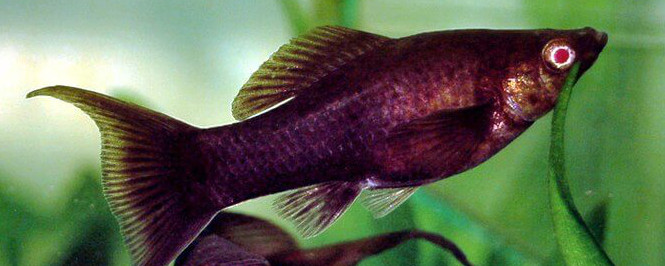
| Max. size: | 5 inches (12.5 centimeters) |
| Suggested aquarium size: | 20 gallons and above |
| Companion ideas: | guppy, danios, female betta, platies, tetras, guppies, swordtails, gouramis, endlers, angelfish |
| Ph: | 7.6 to 8.4 |
| Fish tank type: | Freshwater |
The true Black Molly (Poecilia sphenops) is a highly demanded freshwater fish species well-known among aquarists and aquarium enthusiasts for its charming beauty and algae-consuming characteristics. They are native to Central and South America and are widely popular for their ability to control algae and adapt to various tanks.
Wait, black molly is an algae eater?
You bet.
Performing a simple YouTube search would reveal video proof for the skeptics. Here’s a 25-second-long video where it feasts on the notorious black beard algae.
The true Black mollies persistently scavenge the Algae in the aquarium, thus eliminating algae growth.
They methodically scrape the tank, eating algae as they go, and are experts at reaching tight spaces and crevices where algae may be found.
True Black Mollies’ natural inclination towards algae consumption makes them valuable allies in combating algae overgrowth in freshwater tanks.
Now, generally, mollies come in plenty of colors.
However, my experience shows that the True Black Mollies from the well-known Poecilia genus are best at snacking on algae.
They don’t grow large and are a great tropical fish pet.
They constantly roam the aquarium in search of something to snack on.
They’re also livebearers, and breeding them is not rocket science.
If you want to get Black Mollies for your tropical community tank, make sure that the females outnumber the males, or you will witness aggression among their kind.
Peaceful community fish go best as tankmates for the Black Molly.
They are highly adaptable, making them fit and suitable for different water conditions and environments.
True Black mollies should not be kept with other aggressive or awkwardly behaving mates that can harass them or cause stress.
The true Black mollies, with their jet-black color pattern and graceful movement, enhance the aesthetics of the aquarium. These tranquil fish can coexist with other fish such as mollies, tetras, etc.
Proper and regular care must be taken to maintain the health and well-being of the true Black mollies in the aquarium.
It is recommended that a minimum size of 29-gallon aquarium will be suitable for a group of true Black mollies.t The bigger size tank should be the best option if it is viable.
They live best in an environment of 75°F to 82°F (24°C to 28°C) with water that is slightly alkaline to neutral and has a pH range of 7.0 to 8.5. They can live with a variation in water hardness, but they prefer moderately hard waters.
Offer a balanced diet containing the required nutrients to fulfill fish’s dietary requirements. Feed should contain good quality flake or pellet food, and algae-based foods should also be provided for fish’s healthy upbringing.
Using plants, driftwood, and hiding places to build a den for your baby fish can provide them with not only a hospitable environment but also opportunities for exploration and protection. One of TBF’s characteristics is Black Molly’s preference for a stockroom that is nicely decorated and unique enough to stimulate them.
8. Royal Whiptail Catfish (Sturisoma panamense)

| Max. size: | 8 inches (20.3 centimeters) |
| Suggested aquarium size: | 30 gallons and above |
| Companion ideas: | gouramis, danios, rasboras, corydoras, neon tetras, school of kuhli loaches |
| Ph: | 6.0 to 7.2 |
| Fish tank type: | Freshwater |
The royal whiptail catfish is an excellent freshwater species well-known for its algae-eating tendency and good look. It is native to South America, particularly Panama and Columbia. It is scientifically called Sturisoma panamese.
This armored catfish comes from the Sturisoma genus.
The diet of the Royal Whiptail Catfish (sometimes called Twig Catfish) is mainly vegetable matter.
It will actively graze on algae and occasionally on the biofilm of your driftwood.
Their herbivore feature gives them a prominent nutrient absorption role, which is of great benefit during algae treatment in freshwater aquarium systems.
Contrary to some other algae-eating fish kinds, which tend to pick out one variety of the algae species and only feed on that particular algae type, Royal Whiptail Catfish are multi-dimensional algae grazers that can satisfy their appetite off a vast array of algae types.
This approach includes all the common types of algae, from general types such as green algae and diatoms to tougher types like brush algae.
Their feeding behavior is a slow process in which they delicately scan surfaces for any available algae. They scrape the algae off surfaces with their apt mouthparts, leaving algae-free sections. While doing so, they create an aesthetic spectacle and promote healthy relations behind the scenes.
Royal Whiptail Catfish are peace-loving, and you could keep them in the same tank with many different aquarium freshwater fish species. Nonetheless, you must maintain them with species that are not fleet-footed or vexatious as they may scare or irritate them. The suitable tankmates of this fish are peaceful fish, like tetras, rasboras, and peaceful cichlids.
Speaking of which, this fish is nocturnal and will need plenty of hiding places where it can hang out during the daytime.
You won’t see it very often, true, but you won’t see algae as well.
The whiptail has a unique appearance (as you can see in the photo) that kind of puts it on the exotic side of freshwater fishkeeping. I’ve included it in my article about the most cool-looking aquarium fish that one can own.
Note that you should still supplement its diet; even if your tank is blooming with algae, this species needs diverse sources of food.
I wouldn’t exactly say that it’s a beginner-level fish as well.
The twig catfish are very sensitive to water parameters; they need well-oxygenated tank water with a current, and don’t do well in communities with non-friendly tank mates.
A full-grown Royal Whiptail Catfish reaches nearly 8 inches, placing it among the largest freshwater fish that will be interested in eating algae.
Appearance: One of the unique characteristics of the Royal Whiptail catfish is their elongated, slim body pattern, like a whip, thus receiving the name Royal Whiptail catfish. Owing to this morphology, they can swim and move through tight spaces in the aquarium. They are charming and fascinating due to their body build. They possess a brownish-gray color pattern.
Care Needs: To ensure the well-being of Royal Whiptail Catfish, certain care requirements must be met.
1. Tank Size: These catfish require spacious aquariums with plenty of hiding spots and open swimming areas. A tank size of at least 30 gallons is recommended for a small group of Royal Whiptails.
2. Water Parameters: Maintain stable water parameters within the following ranges: temperature between 72-78°F (22-26°C), pH between 6.5-7.5, and water hardness around 2-15 dGH.
3. Substrate and Decor: Provide a sandy or fine gravel substrate to mimic their natural habitat.
9. Pygmy suckermouth (Otocinclus affinis)

| Max. size: | 2 inches (5 centimeters) |
| Suggested aquarium size: | 20 gallons and above |
| Companion ideas: | rasboras, dwarf gouramis, corydoras, neon tetras, danios, female betta |
| Ph: | 6.8 to 7.6 |
| Fish tank type: | Freshwater |
Pygmy Suckermouth (Otochinckus affinis) is a tiny freshwater species highly regarded for its algae growth control within the aquarium. They are native to South America
Coming from the Otocinclus genus, the Pygmy Suckermouth (or Otocinculus) will mainly snack on softer blue and green hair algae.
It will roam the tank non-stop, looking for its delicious treat.
The Otocinculus won’t harm any aquatic plants; it will only eat algae.
That being said, you should still provide some sinking wafers, other vegetables, and the occasional frozen bloodworm.
Pygmy Suckermouths are devouring algae grazers, constantly scraping surfaces such as rocks, plants, and glass for algae growth. Their diet consists of various types of algae, including green algae, diatoms, and even some forms of cyanobacteria.
By consuming algae, Pygmy Suckermouths help prevent excessive algae buildup, cleaning the aquarium from algae overgrowth, which can otherwise lead to poor water quality, oxygen depletion, and unsightly tank conditions.
Integrating Pygmy Suckermouths into an aquarium ecosystem helps maintain a natural balance between algae growth and other aquatic organisms, which is important for the aquarium’s overall health and beauty.
The Pigmy Suckermouth is as peaceful as it gets.
Perhaps, that’s because of its relatively small size – no more than 2 inches for an adult Oto.
With a maximum size of 2 inches, the Otocinculus is classified as one of the smallest freshwater fish species that eat algae in the aquarium trade.
It seems like the perfect algae eater, right?
Not so fast.
This fish is quite fragile and requires pristine water quality and parameters.
Beginner fishkeepers often have difficulties keeping one alive for long periods.
Tips for Care in Aquarium Settings:
1. Tank Size and Setup:
· Provide a tank with a minimum size of 10 gallons for a small group of Pygmy Suckermouths.
· Incorporate live plants, driftwood, and hiding spots to mimic their natural habitat.
· Opt for a smooth substrate to prevent abrasions on their undersides.
2. Water Parameters:
· Maintain stable water conditions with a pH level between 6.5 to 7.5.
· Keep the water temperature in the range of 72°F to 78°F (22°C to 26°C).
· Ensure moderate water hardness levels for their optimal health.
Pigmy Suckermouths are tranquil and peaceful, ideal for community tanks. They can cohabit with a variety of fish species, such as tetras, rasboras, and small cichlids.
Pygmy Suckermouths should not be kept with larger or aggressive species that may harass or harm the pygmy Suckermouths.
I remember my first Pygmy Sucker – it lasted 2 days in my tank. Lesson learned – I had to step up my game and educate myself more on how to keep stable aquarium water before getting another one.
10. Rosy & Cherry Barbs (Pethia conchonius & Puntius titteya)
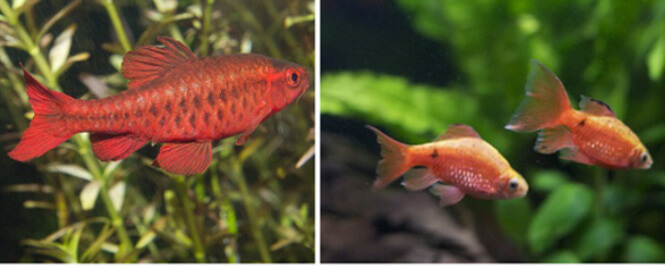
| Max. size: | 2 inches (5 centimeters) for Cherry barbs and 6 inches (15.2 cm) for Rosy bars |
| Suggested aquarium size: | 10 gallons (Cherry barbs) and 30 gallons (Rosy barbs) |
| Companion ideas: | rasboras, corydoras, small plecos, neon tetras, danios, otocinculus, clown loaches, platies, mollies, goldfish |
| Ph: | 6.2 to 8 |
| Fish tank type: | Freshwater |
Rosy Barbs, scientifically known as Pethia conchonius, and Cherry Barns, known as Puntius titteya, are freshwater fish species known for their radiant colors and effective algae-eating habits.
Rosy Barbs are attractive and native to South Asia. They primarily feed on small invertebrates and plant matter, but they also consume algae, notably soft green algae and diatoms.
Cherry barbs are of Sri Lankan origin and are known for their red color in males and subdued color in females. Both rosy barbs and cherry barbs are omnivores who consume algae as well as other foods.
Rosy Barbs are members of the Pethia genus, and Cherry barbs belong to the Puntius genus in the family Cyprinidae.
Both fish will snack on algae.
The rosy barb and cherry barb are known to mainly graze on the hair-type algae (staghorn or other). If your freshwater aquarium has a severe hair algae problem, these two fish are considered among the best options as a solution.
Both are really beautiful community tank fish, with cherries being the friendlier of the two.
Behavior:
Foraging Behavior: While Rosy Barbs and Cherry Barbs are busy fish looking for food, they are actively going through their habitat. Though they are unlikely to feed on algae exclusively, they might consume some algae as part of a balanced diet alongside other food items in your aquarium.
Schooling Nature: Regular unsocial life, they are species of Rosy and Cherry Barbs and they like living with groups of their kind. Maintaining them in the schools of a minimum of three individuals automatically will remind them of their natural behavior while keeping stress levels down.
Active Swimmers: These barb species use their energetic swimming behavior to race up the tank, swing around, and maintain the balance and life of the aquarium.
Compatibility:
Tankmates: Rosies and Cherry Barb are usually peaceful and suitable for housing with other peaceful fish, such as Tetras, Barbs, Danios, and some kinds of small catfish.
Avoid Aggressive Species: These fish must not be in a tank with predatory fish who might tease or prey on them.
Rosies may nip the fins of long-finned fish, but that’s about it. If they are kept in a school of 3 to 5 specimens there will be no aggression.
They will also swim together, but only if there are many of them in a larger tank (think 55 gallons).
Cherry barbs are peace lovers. They avoid conflict and go about their business, which is often eating things from around the aquarium.
They will be more than happy in a group of 3 (1 male with 2 females).
The rosy barbs can grow up to 6 inches, whereas the cherry barbs will not outgrow 2.
The cherry barb’s tiny maximum size makes it a perfect choice as an algae eater in a 10-gallon freshwater aquarium. This fish rarely reaches 2 inches (5 centimeters) in length, which suits most smaller tanks best.
Care Requirements:
1. Tank Size: . Tank size should be 20 gallons for a small group of Rosy or Cherry Barbs. Larger tank size is recommended as it allows free swimming and movement for fish
2. Water Parameters: The pH requirement for Rosy and Cherry barbs is between 6.5 to 7.5, with temperatures ranging from 72°F to 78°F (22°C to 26°C), and moderate water hardness.
3. Diet: They are not dependent on algae for food, so they can eat a wide range of food classes, such as flakes or pellets.
4. Aquarium Setup: Offer ample hiding spots, plants (live or artificial), and open swimming areas to accommodate their active nature and provide security.
The diet of both species should not only consist of algae – a softened vegetable such as zucchini or cucumber will be appreciated.
If I were to choose between the two species, I’d go for the Cherry barb. They remain smaller and more peaceful, and I like their unusual pink coloration.
Rosy barbs are among the very few algae-eating fish that are compatible with a goldfish, along with the rubber-lipped and bristle-nose pleco.
11. Common goldfish (Carassius auratus)
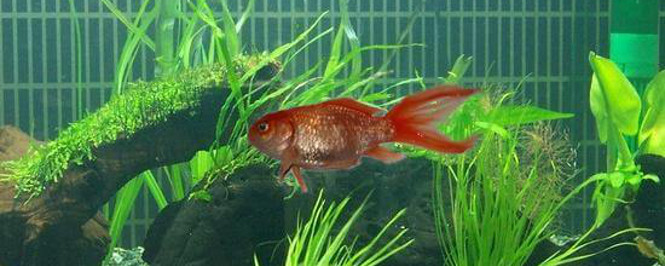
| Max. size: | depends on the size of your tank, but usually around 4 to 5 inches ( 10 to 12.7 cm) |
| Suggested aquarium size: | 30 gallons and above |
| Companion ideas: | topminnows, loaches, rosy barbs, zebra danios, smaller plecos |
| Ph: | 7.1 to 7.6 |
| Fish tank type: | Freshwater |
The common Goldfish, known as Carassius auratus, is a freshwater fish species that originated in East Asia in China. Records show that they were selectively bred from a wild carp species called the Prussian carp or Gibek carp over a thousand years ago during the Tang Dynasty
The Common goldfish is a species within the Carassius genus.
Though classified as omnivores, these fish are notorious for eating all kinds of aquatic plants.
And this includes consuming algae.
Goldfish eat algae and have developed an appetite for algae among other aquatic vegetation. However, they prefer colder temperatures and are not a good addition to tropical community tanks, in general.
The goldfish is recommended as a means of biological algae control for ponds and stock watering tanks.
The appetite of Carassius auratus is related to the fact that they have no stomach.
This forces them to constantly look for food, and if they don’t find protein – they’ll snack on plants and algal growth.
When keeping goldfish, be aware that they produce copious waste and are a lot “dirtier” than other fish of their size.
You should also know that whatever plants you may have in your aquarium will not be safe from this devourer. That’s, of course, if you have not carefully researched your plant selection. Visit this article to discover some plants that would work in a goldfish tank.
It’s recommended that you get a goldfish for algae control only if you have decent filtration, the right tank mates, and no other plant matter in your fish tank.
They are not specialized algae consumers, but common Goldfish can indirectly eliminate algae growth in ponds and tanks through their foraging and grazing habits. Here is his help.
Common Goldfish are constant grazers, constantly foraging for food throughout the day. In addition to their primary diet of small invertebrates and plant matter, they consume algae as part of their natural feeding behavior.
Despite algae not being their main food, Common Goldfish can swim and take in as many algae present in ponds and tanks. The grazing and pecking work of the fish keeps with control situations that greatly diminish the levels of algae. This ensures the existence of a much-balanced aquatic ecosystem.
Some Common Goldfish can create green water and muddy fishbowls with their movement because they move and forage sediment and algae colonies away, overturning them. The movement of fish to those places causes the water to aerate and remove areas where algae easily breeds.
Considerations for Care and Tankmates:
Tank Size: That’s all. Goldfish of the common species can get quite big, so you need a huge tank or pond with enough room for active swimming. Please provide at least 20 gallons of water for each fish in aquariums, and if you choose to have fishponds, you must consider a larger volume.
Water Parameters: Keep the water conditions steady within the required pH scale, between 6.5 and 7.5 temperatures ranging from 65°F to 75°F (18°C to 24°C) and water quality maintained through routine clean-ups and filtration.
Diet: Provide an established diet rich in sky-high commercial fish pellets and crumbles as supplemental snacks with foods such as live or frozen ones occasionally. Besides eating algae, avoid the situation wherein it becomes their sole nutrient.
Tank Mates: Goldfish are often neutral and can live in harmony with a range of peaceful fish species. One must consider the similarity in the size of those fish and how they coexist. Keep in mind not to partner them with cichlids or nippy fish, as they tend to harass the sheepfish.
Unique Feeding Habits:
Surface Feeders: Goldfish are surface feeders. They feed on top, such as plants or row the water surface. They are enthusiastic about feeding and will easily fill their mouths with as much food as possible. Placed on a water surface, fish pellets or flakes, if many, encourage natural feeding behaviors, such as striking at food.
Constant Grazers: The fish in this ecosystem have a constant appetite and will fill themselves with algae, plants, and other detritus from their daily diet while committing themselves to cleaning their surroundings.
12. Dolabella Sea Hare (Dolabella auricularia)
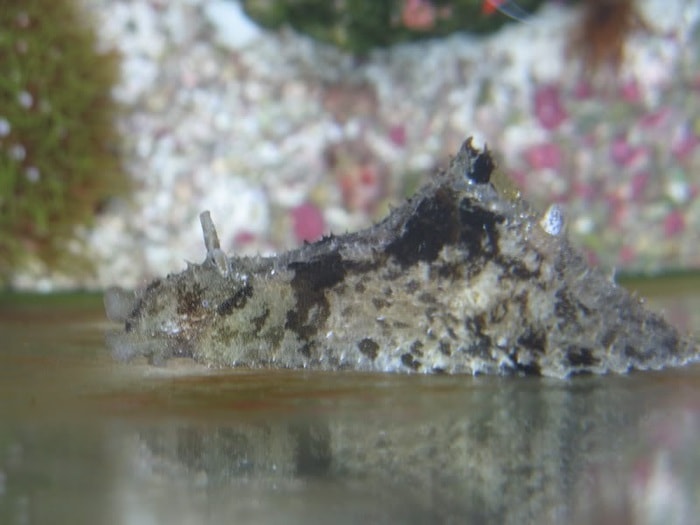
| Max. size: | 16 inches (40.6 cm) |
| Suggested aquarium size: | a 75-gallon tank for a mature specimen |
| Companion ideas: | Peaceful marine fish and invertebrates that would not bother the Sea Hare |
| Ph: | 8.1 to 8.4 |
| Fish tank type: | Saltwater |
We all know that algae is not a freshwater-only problem.
The Dolabella Sea Hare, scientifically called Dolabella auricularia, is a stunning marine mollusk belonging to the Aplysiidae family. It is well known for its appearance and algae-eating habits in aquatic ecosystems.
The Dolabella Sea Hare is a type of sea slug belonging to the Dolabella genus. It feeds almost exclusively on marine algae and is an absolute lawnmower.
The Dolabella Sea Hare possesses a striking and attention-grabbing appearance. It typically has a large, broad, and somewhat flattened body, like the shape of a leaf or an ear, hence its name “auricularia,” which means “ear-shaped.”
Its color can vary,
from shades of brown to green, often with mottled patterns that help it blend in with its surroundings. It has a soft and velvety skin texture that lacks a protective shell, characteristic of mollusks.
Its favorite food in a saltwater aquarium is hair algae. After that, the Dolabella Sea Hare destroys any leftover film algae, which may sometimes include coralline.
Overall, this species of Sea Hare is one of the best saltwater algae eaters in the aquarium trade.
Dolabella Sea Hares are herbivores that feed on various types of algae. They voraciously eat filamentous algae like hair and turf algae.
With the help of specialized mouthparts, which resemble a rasp-like structure called a radula, they graze on algae growing on rocks, coral reefs, and other substrates in their habitat.
This species of sea slug is so effective at removing hair algae that it needs to be relocated when the outbreak is under control.
The Dolabella Sea Hare will wipe off all surfaces it can find but will eventually starve if the algal growth cannot keep up with its eating pace.
Fortunately, many reef keepers are aware of that and it’s a common practice to borrow a Sea Hare from a fellow reefer who’s just had their tank cleaned by the slug.
One thing to know about the Dolabella Sea Hare is that, like most sea slugs from the genus, it could release toxins into the water when spooked.
However, I’m recommending the Dolabella species because they are unlikely to do so.
In the rare event that they do – the toxins will just color up the water but won’t harm your livestock or nuke the tank.
Because of its large size and grazing habits, the Dolabella sea hare is highly efficient at eating algae. Unlike many algae-eating fish species, which are mostly selective in their diet and only graze on algae during certain times, Dolabella Sea Hares are active throughout the day.
Anyway, another thing to consider with the Dolabella Sea Hare is that it grows large. A mature specimen can reach up to 1 foot in length.
However, if you’re doing a part-time rental, you should not worry about it that much, especially if you’re given a younger and smaller specimen.
One thing to keep in mind, though, is the snail’s tank mates. Dolabella Sea Hares should be among non-aggressive saltwater fish species.
Finally, ensure your reef tank powerheads and wavemakers have protective guards on.
This is because it is not unseen for a clumsy Sea Hare to get pulverized by a powerhead…
13. Sailfin Tang (Zebrasoma veliferum)
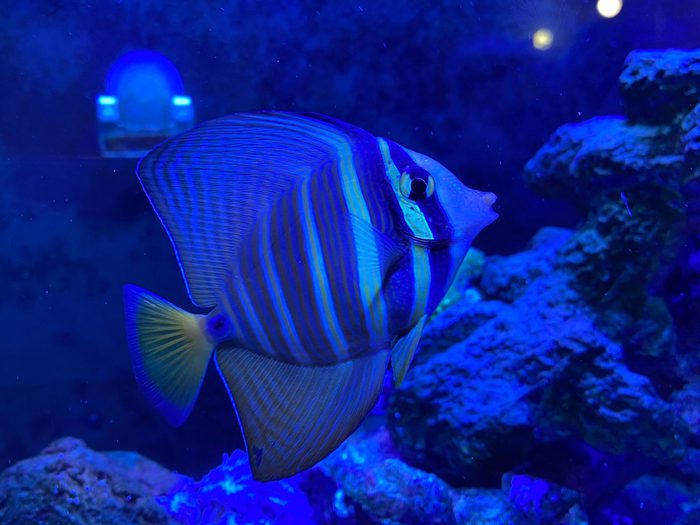
| Max. size: | up to 16 inches (up to 40.6 cm) |
| Suggested aquarium size: | 125 gallons |
| Companion ideas: | Unless you have an enormous tank, don’t house with other Tangs, won’t bother other tank mates |
| Ph: | 8 to 8.4 |
| Fish tank type: | Saltwater |
The Sailfin Tang, scientifically known as Zebrasoma veliferum, is a majestic marine fish highly regarded for its striking appearance and beneficial role in reef aquariums. Originating from the Indo-Pacific region, particularly in the waters around the Maldives, Sri Lanka, and the Philippines, this species is a popular choice among saltwater aquarium enthusiasts.
An adult Sailfin Tang’s diet will mainly consist of saltwater algae.
This fish, from the Zebrasoma genus, is considered an essential addition to a reef aquarium by many hobbyists because it acts as a centerpiece.
However, the Sailfin Tang will also be super active in its search for hair algae, and it will keep a reef tank in check.
Author’s note: The Sailfin Tang will destroy filamentous marine algae, a type of hair algae that is soft, thin, and looks like a mesh. This is essentially what happens when you leave film algae to grow for too long. However, the Sailfin Tang won’t be interested in eating string-like growth, such as the more robust species of Green Hair Algae.
Sailfin Tang, the fish from the reef aquariums, is a very beautiful and rare fish to have. It is now a prized trophy kept by many aquarists everywhere. Humongous yellow bodies with black stripes and extended dorsal and anal fins are what make the Sailfin Tangs stand out as eye-candy of the marine world in my eyes.
It’s like a wind moving on its fins in the ocean. These fish’s large and round body shapes and their keeping-low-to-the-surface style swimming skills make a beautiful addition to any reef tank. It is a captivating underwater spectacle many people pay high prices to enjoy.
Not only does it add to the aesthetic value of reef aquariums, but the Sailfin Tang also serves the practical purpose of being a skilled algae-eater. Being herbivores, they show insatiable feed during the molting season on types of algae such as hair, filamentous, and macroalgae, among others.
They graze on surfaces covered by diatoms, such as coral reefs, rocks, and several other substrates. This ultimately reduces algal growth and eliminates unsightly blooms from the aquarium that may smother corals and disrupt the ecological balance.
Another reason why this fish is so popular is that it gets along well with other community fish, as long as they don’t come from the same family (“surgeon” fish).
It has been documented that the Surgeonfish family supports the health of a reef and is known as the “lawnmowers of the sea”.
They are herbivores, and algae are a main part of their diet.
Feed your beautiful Sailfin Tang with algae wafers and flake food whenever you run out of yours. Don’t feed lettuce though.
14. Ramshorn snail (Planorbidae)

| Max. size: | 0.7 inches (2 centimeters) |
| Suggested aquarium size: | Any |
| Companion ideas: | Otociculus, Corydoras and other peaceful fish, Ghost shirm, Cherry shrimp, Bamboo shrimp, nerite snail, mystery snail, trumpet snail, pond snails, DON’T house with fish from the Botia genus, as most loaches are known to eat freshwater snails |
| Ph: | 6.6 to 7.6 |
| Fish tank type: | Freshwater |
Want to get a snail that rivals even the best algae-grazing fish in terms of efficiency?
Enter the Ramshorn snail.
The origin of the Ramshorn Snail (Planorbidae) can be traced back to various freshwater habitats worldwide. This species is native to regions across Europe, Asia, Africa, and the Americas, where it inhabits lakes, ponds, rivers, streams, and other freshwater bodies.
These guys, mollusks within the Planorbidae family, are phenomenal at eating algae. They can clean up a decently sized aquarium in a matter of DAYS.
They have a plain look to them and multiply like crazy, but you’ll have your tank polished from top to bottom.
The Ramshorn Snail shells are recognized as distinct characters that can be of any color, from brown to red and sometimes even translucent. They look like an image captured by Dr. Seuss, with the resemblance of a spawned shell either in a spiral or that of a ram horn, so they are named the Ramshorn. The snail enters this shell that has a flattened body and a single pair of tentacles: one is the eyes, and the other is considered a sensory organ.
When questioned about breaking the algae in a densely planted setup, the Ramshorn snail is usually the first choice. In addition to her algae-eating skills, this snail will never feed on aquatic plants or any other vegetation matter. These vegetation matter only includes those that are dead and decaying.
These snails are grazers of nature and are constantly at war against algae growth within the aquarium. In particular, they have an appetite for different algal types, including green algae, brown algae, diatoms, and some forms of cyanobacteria.
Ramshorn Snails multiply to occupy places covered by alga, such as the glass, substrate, ornamentation, and leaves of plants. They are thus able to inhibit fast-growing algae from proliferating, which can protect aquariums from the risks of algal blooms everywhere and create an undesirable aquarium environment.
Water dwellers use the Ramshorn snails instead of algae chemicals or water mechanics as their algae control solutions.
However, Ramhorn Snails in planted aquariums are good in chains for their docile nature and low impact on aquatic plants. Other snails could be aggressive and might nibble on a live neighboring ornamental plant, but Ramshorn Snails hunt on barely visible algae and decaying matter without harming the plants.
In turn, a ramshorn snail is another player often overlooked in planted aquariums but could help improve the system by loosening the substrate, filtering the excess debris, and preventing the formation of anaerobic pockets and undesired nutrient buildups. They can also contribute to a thriving, full-fledged, planted aquarium ecosystem, allowing greenery and life to blossom.
Ramshorn Snails coexist harmoniously with live plants, rarely causing damage or disrupting their growth. They help maintain a clean and algae-free environment, benefiting planted tank inhabitants by promoting optimal photosynthesis and nutrient uptake conditions.
Furthermore, Ramshorn Snails can benefit planted tanks by aerating the substrate and consuming excess organic matter. Their activities help prevent the accumulation of detritus and organic debris, reducing the risk of anaerobic conditions and nutrient imbalances in the substrate.
Seriously consider getting a couple of these if that’s your situation.
15. Nerite snail (Neritina natalensis)
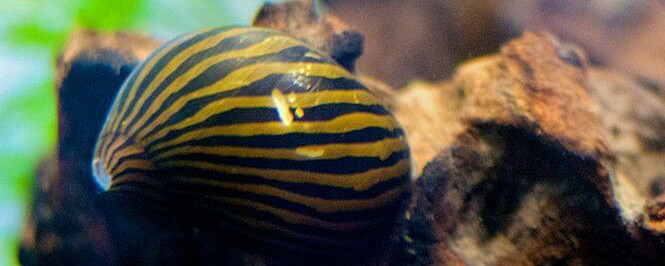
| Max. size: | 1 inch (2.5 centimeters) |
| Suggested aquarium size: | 5 gallons and above |
| Companion ideas: | smaller peaceful community fish, shrimp and other snails, NO cichlids, goldfish, loaches or crayfish |
| Ph: | 7 to 8.4 |
| Fish tank type: | Freshwater & Saltwater |
Did you know that there’s this elite club of aquatic cleaners?
If yes, then you probably know that the Nerite snail is an honorable member of the Aquarium Clean-up Crew for freshwater tanks.
The Nerite Snail (Neritina natalensis) is a popular freshwater gastropod known for its distinctive appearance. Originating from freshwater habitats in Africa, including rivers, streams, and lakes, Nerite Snails have become sought-after additions to freshwater tanks worldwide.
Coming from the Neritina genus, these snails do an outstanding job regarding microalgae control.
Nerite Snails are characterized by their small, cone-shaped shells with intricate ridges and patterns. The shells come in various colors and patterns, including black, brown, olive, and yellow, adding visual interest to aquariums. These snails typically have a muscular foot that allows them to move smoothly across surfaces, grazing on algae and detritus as they go.
One of the primary roles of Nerite Snails in freshwater tanks is algae control. They target algae species such as green and soft algae, helping keep the tank clean and free of unsightly algae growth.
The Nerite snail actively eats brown algae (also known as diatoms). A single Nerite snail can eat the brown microalgae in a 10-gallon fish tank alone.
Brown algae, also known as diatoms, can be a common nuisance in freshwater aquariums, especially during the initial cycling phase or in tanks with elevated nutrient levels. While some algae-eating species may ignore brown algae, Nerite Snails are highly effective at consuming this type of algae.
Nerite Snails use their radula, a specialized feeding organ equipped with tiny teeth, to scrape algae off surfaces such as glass, substrate, and decorations. They methodically graze on brown algae, gradually reducing their presence in the aquarium.
If you’re skeptical, then look at this video.
This snail species is as peaceful as it gets and gets along with almost any aquarium occupant.
They will roam around your tank at their super-slow snail speed, looking for algae and other uninvited organic matter to snack on.
Don’t add too many of these guys, as later, they won’t have enough algae to munch on.
A single Nerite snail per 5 to 10 gallons will be more than enough, so you don’t need to go for all the members of the Algae Clean Up Crew here.
Note: Though Nerite snails look cool and eat algae, some people find their eggs very unsightly and remove them through various means.
Removing the eggs of a Nerite snail is not an easy task.
16. Malaysian Trumpet snail (Melanoides tuberculata)
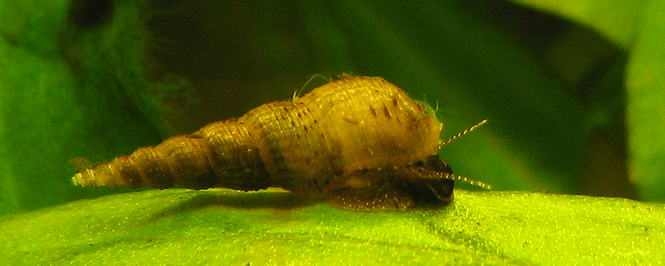
| Max. size: | 1 inch (2.5 centimeters) |
| Suggested aquarium size: | 5 gallons and above |
| Companion ideas: | smaller peaceful community fish, shrimp and other snails, NO cichlids, goldfish, loaches or crayfish |
| Ph: | 7 to 7.7 |
| Fish tank type: | Freshwater & Brackish |
The Malaysian Trumpet Snail (Melanoides tuberculata) originates from freshwater habitats in Southeast Asia, particularly in regions such as Malaysia and Thailand. These snails are native to various freshwater environments, including rivers, streams, ponds, and rice paddies, where they are often found burrowing into substrate layers and foraging for food.
These tank scavengers are members of the Melanoides genus.
Anyhow, having Malaysian trumpet snails is not for everyone.
They only like to eat soft algae that are growing on hard surfaces. Only get them if that’s the case for you.
They only like to eat soft algae that grow on hard surfaces. Only get them if that’s the case for you.
Among the countless Malaysian Trumpet Snails, one is a successful algae eater known for its ability to eat soft algae such as green algae and diatoms.
Such snails utilize their radula, an organ that consists of tiny teeth used for scraping, to get rid of algae off of aquarium glass, substrate, and decorations. The unceasing activity of these grazers prevents the aquarium from being taken over with algae and sustains the aquarium’s visual clarity.
Multiple factors should be consulted before including Malaysian Trumpet Snails in your aquarium; they need to be comfortable around their tank mates and grow comfortable there. These considerations include:
Tank Size: The varieties of Malaysian Trumpet Snails can be placed in a , can serve as a conducive environment for the fish to grow and reproduce normally without congestion.
Water Parameters: Malaysian Trumpet snails can survive in a range of water conditions, but they prefer non-fluctuating parameters such as pH levels ranging from neutral to slightly alkaline water and hardness at moderate levels. Water changes at regular and right filtration are some of the ways through which water quality can be maintained and support the health of the snails. In addition, they help in controlling the ammonia levels.
Substrate Type: Forestalling Malay Trumpet Snails are burrow breeds that must hold a proper substrate for their burrowing and foraging activities. Like earth snails, the sand and gravel environment should suit these snail organisms perfectly; they can easily bury themselves in the substrate layers’ depth and search for plant matter, shielded from predators.
Some hobbyists avoid them and some love them.
It’s a controversial pick really, so if snails are your weapon of choice consider the others mentioned on this list as well.
17. Turbo snail (Turbo fluctuosa)
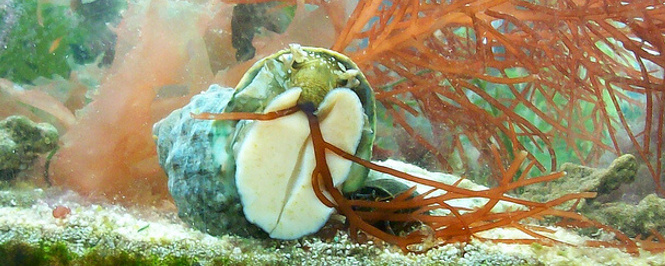
| Max. size: | 2 inches (5 centimeters) |
| Suggested aquarium size: | 20 gallons and above |
| Companion ideas: | most any reef-safe fish, but don’t house with other algae-grazers as the Turbo snail won’t be able to compete for food |
| Ph: | 8 to 8.4 |
| Fish tank type: | Saltwater |
The Turbo Snail (Turbo fluctuosa) originates from tropical and subtropical regions of the Indo-Pacific, including areas such as the Philippines, Indonesia, and the Great Barrier Reef. These marine gastropods are native to shallow coastal waters with warm temperatures and abundant algae growth, where they play a vital role in marine ecosystems.
The Turbo snail is assigned to the Turbo genus of sea snails.
Turbos are heavy artillery when it comes to battling algae in marine tanks.
The Turbo Snail is characterized by its large, conical shell with prominent spiraled ridges and a glossy surface. The shells typically feature vibrant colors ranging from shades of brown and tan to green and blue, adding visual interest to aquariums. Turbo Snails have a muscular foot that allows them to glide smoothly across surfaces.
They get big, and they eat big.
Unlike other marine snails in the trade, the Turbo snail doesn’t prefer a specific type of algae. It will eat anything from microalgae to hair algae non-selectively.
These guys grow large and heavy. Your live rock should be well positioned and secured because it’s not unseen that a fat turbo knocks a piece of rockwork here and there.
These snails are efficient grazers, feeding on various types of algae that can accumulate on aquarium surfaces. They target algae species such as diatoms, cyanobacteria, and hair algae, helping to prevent the proliferation of unsightly algae blooms and promoting a cleaner and more balanced aquarium environment.
Keep in mind that these guys are so effective at cleaning unwanted algal growth that you won’t need more than two or three for a large aquarium.
Several factors should be considered to ensure their compatibility and well-being:
1. Tank Size: Turbo Snails can thrive in various tank sizes, from small nano tanks to larger reef setups. However, larger tanks with ample space and suitable hiding spots allow them to explore and forage more freely.
2. Water Parameters: Turbo Snails prefer stable water parameters consistent with those found in natural reef environments. These include a temperature range of 72°F to 78°F, a pH range of 8.1 to 8.4, and a specific gravity of 1.023 to 1.025. Regular water testing and maintenance help ensure optimal conditions for Turbo Snails and other tank inhabitants.
3. Tank Mates: Turbo Snails are generally peaceful and compatible with many marine fish, invertebrates, and corals.
Turbo Snails are reef-safe.
Avoid putting the Mexican Turbo snail in tropical reef tanks, as it won’t tolerate warm water temperatures.
18. Amano shrimp (Caridina multidentata)

| Max. size: | 2 inches (5 centimeters) |
| Suggested aquarium size: | 10 gallons and above |
| Companion ideas: | Betta fish but with caution and in a more spacious tank, neon tetras, tiger barbs, guppies, discus, otocinculus, corydoras, smaller plecos, cherry shrimp, bamboo shrimp, peaceful snails |
| Ph: | 6.2 to 7.2 |
| Fish tank type: | Freshwater |
The Amano Shrimp, scientifically known as Caridina multidentata or Caridina japonica, originates from Japan. These freshwater shrimps are native to various freshwater habitats in Japan, including rivers, streams, and ponds.
This species of freshwater shrimp is from the Caridina genus.
The Amano shrimp generally became popular after Takashi Amano introduced it to the aquarium trade.
Takashi Amano is an iconic figure in the hobby, and I recommend reading his stuff, but that’s a topic for another discussion.
Amano Shrimp are characterized by their translucent bodies adorned with thin red-brown bands and distinctive whisker-like appendages called antennae. They typically grow to around 2 inches (5 centimeters) and are known for their active and inquisitive behavior.
Anyway, this shrimp has been known to absolutely love and even depend on algae. For this reason, it should only be added to an already-established aquarium.
Amano Shrimp have earned their status as efficient algae eaters due to their ability to consume a variety of algae species commonly found in freshwater aquariums. They feed on soft algae varieties such as green algae, brown algae (diatoms), and hair algae, all of which can proliferate and detract from the aesthetic appeal of aquariums if left unchecked.
Amano shrimp will eat and even prefer grazing on hair aquarium algae. Having some green or another type of hair-like freshwater algae is recommended for this shrimp species.
Be careful not to end up with another species of Caridina (as there are hundreds) because they will not be as good at battling algae as the Amano shrimp.
When considering tank companionship for Amano Shrimp, several factors should be considered to ensure their compatibility and well-being: Fish Compatibility: Amano’s shrimp is not dangerous to sociable fish types such as non-aggressive or non-predatory.
Thus, this shrimp is acceptable to most freshwater fish types that are not antisocial. Small—to medium-sized community types like tetras, rasboras, guppies, or a few tough-looking cichlids will act as very good tank mates, while the smallest shy types like cats and sharks are recommended for the tank type.
Invertebrate Compatibility: Amano shrimps are also perfect partners for peaceful freshwater-grade invertebrates like snails and shrimps.
Tank Setup: Shrimp belonging to this species will thrive if aquarium water parameters are regular and stable with plenty of hiding places to serve as overnight residences. What’s inside their tank will help them to feel at ease. Use secure plants, driftwood, rocks, and caves. By doing this, they will be healthy and fish care will be pleasant too.
Water parameters: Native Amano Shrimp live in an intertropical freshwater area that is moderately alkaline (pH 7-8) and has a water hardness of 120-200 ppm. These organisms respond to water parameters by moving, whether the changes exceed the allowable limit. Therefore, the environmental factors should be varied but within the recommended limits’ ranges.
A true Amano will be larger and very active in the tank.
19. Red cherry shrimp (Neocaridina davidi)

| Max. size: | 1.5 inches (3.8 centimeters) |
| Suggested aquarium size: | 5 gallons and above |
| Companion ideas: | neon tetras, otocinculus, corydoras, smaller plecos, bamboo shrimp, amano shrimp, peaceful snails |
| Ph: | 6.5 to 8 |
| Fish tank type: | Freshwater |
The Red Cherry Shrimp (Neocaridina davidi), also known as Cherry Shrimp or Sakura Shrimp originates from Taiwan. These freshwater shrimps were selectively bred from wild native to Taiwan’s rivers and streams.
The Red Cherry shrimp belong to the Neocaridina genus and have exploded in popularity in past years and for a reason.
Red Cherry Shrimp are characterized by their bright red coloration, which varies in intensity from a deep crimson hue to a vibrant cherry red. They typically have a translucent body with contrasting red markings, creating a striking visual impact in the aquarium.
Red Cherry Shrimp are relatively small, reaching up to 1.5 inches (3.8 centimeters), making them ideal for nano tanks and planted aquariums.
They’ll munch mostly on soft green algae and some occasions on hair algae but are not a good choice when exclusively battling that.
Red Cherry Shrimp has gained immense popularity in freshwater tanks due to several factors. Firstly, their striking red coloration adds visual interest and vibrancy to aquariums, enhancing the overall aesthetic.
Additionally, Red Cherry Shrimp are prolific breeders, with females capable of producing multiple batches of offspring under favorable conditions. This makes them an excellent choice for aquarists interested in breeding shrimp or creating self-sustaining populations within their tanks.
The Cherry shrimp will multiply fast if none of their natural predators are in the tank.
It’s noteworthy that being so small, bright red, and a fast multiplier signals that you’re probably on the bottom of the food chain.
If you resort to these algae grazers, you should carefully pick their tank mates if you want them to sustain a stable colony.
In a perfect world, tankmates should be members of species that have no predatory intentions and don’t cause any problems to our shrimps. Suitable tank mates for Red Cherry Shrimp include:
Tiny to middle-sized freshwater fish species that are not aggressive or agile, for instance, rasboras, tetras, guppies, and dwarf corydoras catfish.
In addition to neutral cursers, medium to large, well-behaved invertebrates such as other Neocaridina sp., Caridina sp. snails, and freshwater crabs will also do well.
The necessary live plants and algae-eating organisms, like snails, contribute largely to providing additional hiding places and grazing areas for the shrimp and bring more balance into the aquarium’s artificial ecosystem.
Usually, an aquarist will add these to their heavily planted tank that has dwarf community fish in it.
20. Sulawesi shrimp (Caridina dennerli)
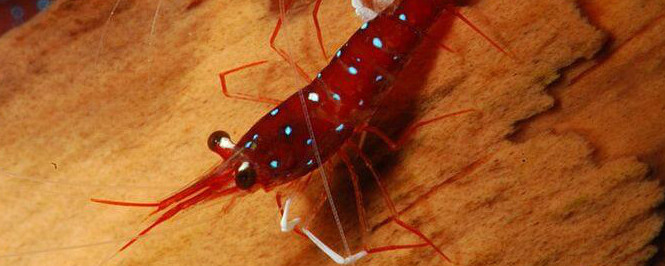
| Max. size: | 1 inch (2.5 centimeters) |
| Suggested aquarium size: | 5 gallons and above |
| Companion ideas: | Sulawesi biotope snails such as the Sulawesi Rabbit snail, other Sulawesi shrimp |
| Ph: | 7.5 to 8.5 |
| Fish tank type: | Freshwater |
Sulawesi Sulawesi Shrimp, scientifically known as Caridina dennerli, are an amazing and attention-grabbing species of freshwater shrimp originating from the island of Sulawesi in Indonesia.
Coming from the widespread Caridina genus, the Cardinal Sulawesi shrimp has earned the respect of fishkeepers for both its appearance and algae-devouring abilities.
Sulawesi Shrimp are popular for their radiant and vivid color pattern, making them a captivating addition to freshwater aquariums. They generally display a stunning combination of bright red, orange, and white markings on their body. They add aesthetic value to aquariums due to their outstanding appearance.
In terms of size, Sulawesi Shrimp are relatively small, reaching lengths of up to 1 to 1.5 inches (2.5 to 3.8 centimeters) when fully mature. They have slender bodies with long antennae and delicate appendages, giving them an elegant and graceful appearance.
Leafless aquatic plants are the main part of this shrimp’s diet, so algal growth is encouraged while housing it in your aquarium.
Mind that the Cardinal shrimp are quite sensitive to fish tank conditions.
They appreciate very clean water.
Another thing to consider if you want these colorful creatures to clean your tank is that they are rarely found in fish stores.
You’ll have a better chance of getting one if you contact someone who’s breeding them.
In addition to their stunning look, Sulawesi Shrimp have several unique qualities that set them apart from other shrimp species.
Sulawesi Shrimp are endemic to the unique freshwater ecosystems found on the island of Sulawesi, where they inhabit lakes, rivers, and streams with alkaline water conditions and high mineral content.
Sulawesi Shrimp are well known for their sensitivity to water parameters like pH and hardness levels. They need stable and well-maintained water parameters.
Since this shrimp species is hard to find and more expensive, aquarists often keep them in Sulawesi biotope tanks to reduce the risk of loss.
Microalgae and biofilm are their favorite snacks.
Maintenance of Sulawesi Shrimp aquarium demands careful monitoring and attention to the quality of water and environmental conditions. Here are some considerations for tank maintenance.
1. Water Parameters: Sulawesi Shrimp inhabit alkaline water conditions with a pH range of 7.5 to 8.5 and hardness levels between 6 to 10 dKH (degrees of carbonate hardness).
2. Substrate and Decorations: Offer a substrate composed of crushed coral, aragonite sand, or specialized Sulawesi mineral substrates to mimic the natural habitat of Sulawesi Shrimp. 3. Filtration and Circulation: Use a gentle filtration system with a sponge or pre-filter to avoid sucking up small shrimp or shrimp larvae.
21. Hillstream Loach (Sewellia lineolata)

| Max. size: | up to 3 inches (around 7 cm) |
| Suggested aquarium size: | 55 gallons for a school of 3 to 4 fish |
| Companion ideas: | Guppies, platies, otocinclus (if you’re careful with matching the Oto’s and the Loach’s temperature preferences); |
| Ph: | 7.0 – 7.8 |
| Fish tank type: | Freshwater |
The Hillstream loach, the scientific name for which is Sewellia lineolata, is a beautiful and charming freshwater fish species of the Ballitiridae family. It is native to fast-flowing streams and rivers in southern Asia, especially in China, Laos, Thailand, Vietnam, etc.
Hillstream Loaches make use of their specialized mouthparts and sucker-like mouths to scour and scrape algae off surfaces. Their streamlined bodies and sturdy pelvic fins allow them to attach to rocks and move swiftly in fast-flowing water.
One of the plus points of Hillstream loaches in algae control is their ability to reach places and points that other algae eaters can hardly reach. They can consume algae from hard-to-reach areas.
Hillstream loaches (Sewellia lineolata) are excellent at dealing with various types of algae, such as brown diatom algae. In rare cases, they will graze on hair algae, such as black beard algae.
The reason I’m mentioning them in this article is because there are not many great hair algae eaters for cold water tanks (freshwater). Use them as a last resort if you keep such an ecosystem at home.
Hillstream loaches can’t survive on algae alone, so you’ll need to provide them with other types of sustenance to keep them healthy.
However, they do require quite a bit of space to open up their appetites.
You’ll need at least 55 gallons of water to keep a school of 3 loaches together.
Keeping Hillstream Loaches in the aquarium, several factors should be considered to ensure their well-being and compatibility:
Hillstream Loaches need spacious aquariums with plenty of swimming space and adequate water flow. A tank size of at least 20 gallons is recommended for a small group of Hillstream Loaches. Larger tanks provide more room for natural behavior and social interactions among the fish.
The natural habitat of Hillstream Loaches can be mimicked by providing smooth river rocks gravel, and sandy substrate. Integrate driftwood, rocks, and caves to create hiding spaces and grazing areas for the fish.
Hillstream Loaches can live in cool, well-oxygenated water conditions with temperatures ranging from 68°F to 78°F (20°C to 25°C). Maintain neutral to slightly alkaline pH levels between 7.0 to 7.5 and moderate water hardness between 5 to 15 dGH (degrees of general hardness).
Hillstream Loaches are tranquil and peaceful fish that can be kept with various community fish species, nonetheless, avoid keeping them with aggressive or territorial fish that may outcompete or harm them.
Moreover, they will need plenty of oxygen since they come from fast-flowing streams and rivers.
Which algae eaters are compatible with aggressive cichlids?
If you’re looking after the particularly aggressive African cichlids, then there are not many options for a healthy coexistence with an algae grazer. Have a look at the algae-eating fish compatible with cichlids:
On some occasions, bristle-nose plecos will be able to keep the algae in check in a cichlid tank. However, you should introduce the pleco earlier when your cichlids are young. This gives both species time to get used to cohabiting with one another.
Another condition for this setup to work is that the pleco should already be decently sized so that it can protect itself in case of aggression.
The third condition to be met is that you provide the Bristlenose with plenty of hiding spaces, enough to keep it safe during the daytime.
Consider adding a small piece of driftwood for the pleco, as it will graze on it because it helps with its digestion.
Driftwood will lower the pH of the water by a tiny bit, so bear that in mind if your cichlids demand a slightly more alkaline tank environment.
Note that African Cichlids are mainly herbivorous and introducing good plant-based Cichlid food such as Spirulina to their diet, may stimulate their appetite for some types of algae.
Which algae eaters are compatible with African dwarf frogs?
With turtles things can get a little more complicated:
Most fish that are not large enough will eventually get eaten, no matter how fast or smart it is. If you get a fish, big enough to fend for itself you won’t have much progress with your algae problem. Larger plecos don’t really eat that much of it. SAEs and Otos get eaten.
A turtle’s temperament may vary but they are all killers.
Older red ear sliders (RES) tend to lean on the herbivorous side more, which gives their fish tankmates higher chances of survival.
Here’s what animal that eats algae and survive in a turtle aquarium:
My best suggestion here would be… ghost shrimp.
I know what you’re thinking and you’re right.
A ghost shrimp will be eaten by the turtle at some point. But they will also do an outstanding job at cleaning the walls and hard surfaces of your tank from algae.
The reason I’m suggesting this exact species of shrimp is that they are super cheap and you can buy tons of them.
By the time your turtle eats a couple, the others may as well learn how to avoid and escape the predator.
Red cherry shrimp are faster and more agile than ghost shrimp but they are also significantly more expensive. It’s up to you.
Author’s note: If you’re dealing with green water in your turtle tank you should know that it’s caused by free-floating green microalgae. Such green microalgae are not something ghost shrimp or any other algae eater can fix.
Which algae eaters are compatible with African dwarf frogs?
African dwarf frogs are violent little creatures. They won’t be compatible with some smaller docile fish. If the frog hasn’t been fed it can even try to eat a larger fish.
Here’s a video of an ADF trying to eat a pygmy suckermouth. For this reason, they should be housed with faster and larger fish or ones that are inhabiting the upper space in the aquarium. Here’s what algae-eating creatures will work with an African Dwarf Frog:
Algae consumers such as mollies, a Bristlenose pleco, or a rubber-lipped pleco will be appropriate for a tank with an African Dwarf frog. Nerite snails could also work, as their shell makes them immune to the frog. Red cherry shrimp are agile enough to escape the frog, but it’s not uncommon for them to lose a limb when the frog’s around.
Do you need to supply these creatures with foods other than algae?
After your tank is free of algae and even during the cleaning process, the aforementioned aquatic species will still need to feed on something else. Listed below are options that will generally fit the healthy diet profile of an algivorous aquarium inhabitant. Do keep in mind that every fish, crustacean or snail has its own personal preferences as with algal consumption. Here’s a list of supplemental food that an algae eater will need:
- spirulina flakes
- sinking algae wafers
- fresh lettuce
- fresh zucchini
- fresh kale
- fresh cucumbers
- green peas
- frozen bloodworm for the omnivorous fish
Following this list will guarantee that your pet will be provided with important vitamins, nutrients, and fiber from diverse food sources.
My conclusion
Picking algae eaters for your aquarium will work if you provide them with a healthy habitat while choosing the right type for your problem. They should feel comfortable in their tank so that they can fully indulge in what they do best.
Know that these creatures are not problem solvers, but rather aid. To fully eradicate the issue you need to dig deeper and find the cause.
In a freshwater tank, the nutrients responsible for the hair algae outbreak may be entirely different than in a reef tank.
Anyway, which algae-eater did you choose?
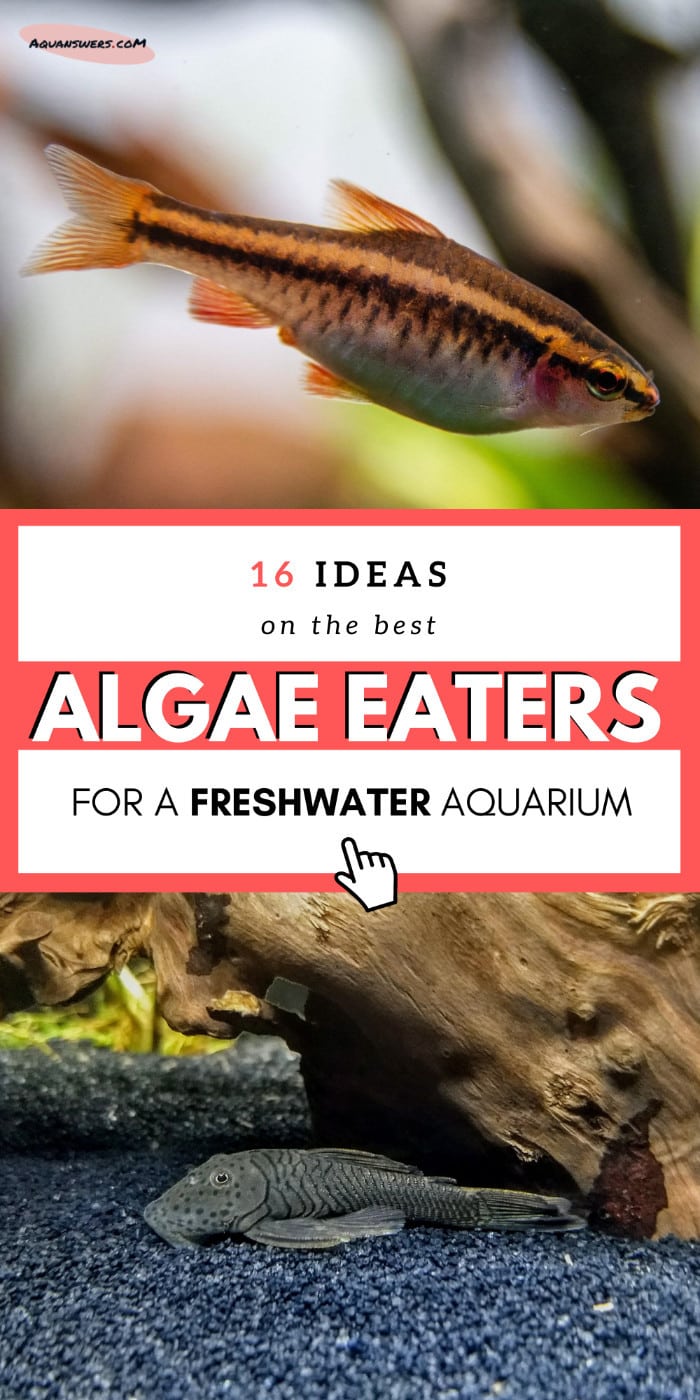
Let me know your experience in the comments so I can update this article and help more fishkeepers out.

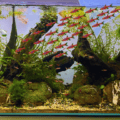
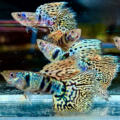


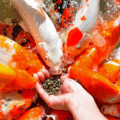
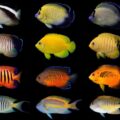
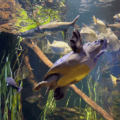



I’ve had otos since I started my tank and I’ve found them to be very easy and hardy things. I have no idea what I’m doing and don’t do really any maintenance. I’ve never had an oto die. However, they only seem to be interested in brown diatoms. I got an infestation of green hair algae, and although the ramshorn snails kept it under control for a while, their population crashed and it’s overgrown the tank. The cherry shrimp and the cherry barbs didn’t do much against it (the shrimp seem mostly interested in brown or soft algae and the barbs aren’t much interested in algae at all). I haven’t found any of the others on this list at my 3 local fish stores.
Hey, how about American Flag fish? I had a tank some time ago that was full of hair algae and the flag fish just chopped away at it. Algae at the end of the day is not bad it is a sign of a healthy tank it is only aesthetically displeasing. However reducing the lighting period and changing other parameters in your tank can greatly help to reduce algae growth. Hopefully these tips help, and thanks for commenting!